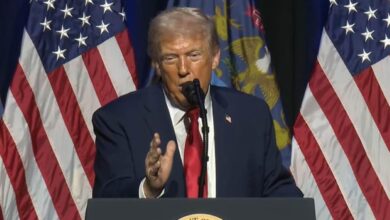The huge deficit of the United States: How’s the “America First” plan?
Listen this article
The Budget Office of Congress affirmed that the deficit of the United States will exceed one trillion dollars in 2020

This would be the biggest deficit in the history of the United States. This is due to the fact that the government's expenditure is greater than its income: while the expenses reach $4,746 trillion, the revenues add up to $3,643. The figures reveal that the deficit for the fiscal year that goes from October 1, 2019, to September 30, 2020, will be $ 1,103 billion, 1% more than the year 2019.
Leer en español: El enorme déficit de Estados Unidos: ¿Cómo va el plan "America First"?
In 2012, the deficit reached one trillion dollars in the government of Barack Obama, due to expenses to combat the financial crisis of 2008. Now, in the government of Donald Trump, expenses have increased. Trump came to the presidency with the promise of reducing the deficit and the federal debt, but despite that, the measures he has implemented in his government such as tax reform, tax cuts and the law of public spending, have made the deficit grows.
Military spending
The first important expense is military investments. In 2001, after the 9/11 attacks, there was an almost double increase in annual military spending, which went from $111.9 billion in 2003 to $150.8 billion in 2019. That expense includes the budget of the department of defense and emergency expenses outside the budget, plus other expenses such as increases for the Department of Veterans Affairs.
US military spending is greater than the 10 largest government expenditures combined. It is four times larger than China's military budget, and 10 times greater than Russia's defense spending.
Tax reduction
The second important factor is the impact of tax cuts. In the future, Trump's tax reduction will reduce revenue because it is lowering the personal income tax rate, corporate taxes, and taxes on small businesses. These cuts total $ 1.5 billion over the next 10 years. But the Joint Tax Committee said the cuts would stimulate growth by 0.7 percent per year. The growth increase will add revenue, offsetting some of the cuts.
The obligatory budget
Finally, another cause of the deficit is compulsory spending programs. Some people point to the cost of Social Security as a contributor to the deficit, as for example the cost of Medicare that will cost $ 702 billion in the fiscal year 2020. However, of that figure, only 49% adds to the deficit, while the rest of the mandatory budget does contribute. This includes Medicaid, which will cost the government $ 426 billion.
Read also: Trump: a trade war with India and Turkey is looming
The mandatory budget also includes $611 billion in social assistance programs such as TANF, EITC, and Housing Assistance. It also includes work benefits for those who were laid off, student loans and other retirement and disability programs for former federal employees. These include public officials, the Coast Guard, and the military.
The trade deficit
The United States has the largest trade deficit in the world since 1975, and the protectionist measures adopted by the Trump government "America First" or "Made in America" opposed to "Made in China" have not worked to reduce it. In 2018, its imports were $3.1 billion and exports reached $2.5 billion. The trade deficit alone in goods was $891 billion.
The deficit has increased despite the trade war started by President Donald Trump. This is due, in part, to the strengthening of the dollar in 2018, as a strong dollar makes imports cheaper and exports more expensive. The protectionist measures that Trump has imposed include a 25% tariff on steel imports and a 10% tariff on aluminum. In response to this, China, Mexico, Canada, and the European Union also announced tariffs, thus hurting United States exports.
Trump's measures that aim to reduce imports postulates that the United States could produce everything it needs, but even if that is true the truth is that some countries can make the same products for a lower price.
The United States has a deficit with countries that fall into at least one of the following categories:
1. They can produce things cheaper than the United States
2. They do not need the products that the United States produces.
3. They market several products with the United States, but the United States imports more products than it exports.
Most of the business partners with which the United States has deficits are in the first two categories, the two largest are China and Japan. On the other hand, some of the countries that fall into the third category are Canada, Mexico, and Germany.
China: $ 660 billion negotiated with a deficit of $ 419 billion.
Canada: $ 617 billion negotiated with a deficit of $ 20 billion.
Mexico: $ 611 billion negotiated with a deficit of $ 81 billion.
Germany: $ 184 billion negotiated with a deficit of $ 68.2 billion.
Japan: $ 218 billion negotiated with a deficit of $ 67.6 billion.
Relations with Latin America
US trade relations with Latin America have not declined in the Trump government despite the new measures imposed and the trade war with China. Regarding investments, the United States continues to be a large investor in the region, with 28% of the flows received. The majority of US investments are concentrated in Central America and Mexico; in the latter, 50% of the total is concentrated.
According to the United States Department of Census, in 2018 there was a growing trend since in the first semester of the year exports from the region to the United States increased by 7.4% in relation to the same period of the previous year, while imports did it by 9.8%. It is expected that in the current year the trend will continue.
LatinAmerican Post | María Fernanda Barinas
Translated from "El enorme déficit de Estados Unidos: ¿Cómo va el plan "America First"?"





